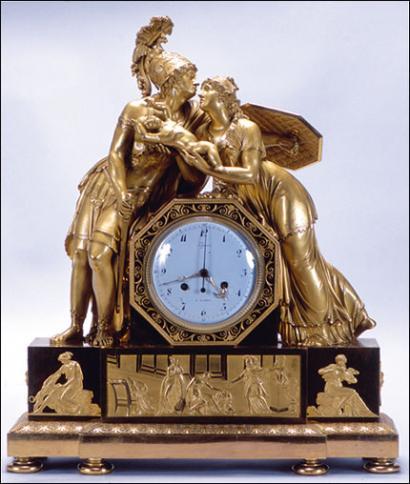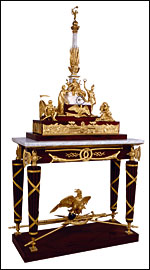
"Les Adieux d'Hector et d'Andromaque" 1805
Horloger Lepaute
Mobilier national, Françoise Baussan
|
|
MUSÉE DU TEMPS
Palais Granvelle
96, Grande rue
25000 Besançon
INFORMATION:
Desk : Tél. 03 81 87 81 50 Fax.03 81 87 81 60
Conservation : 03 81 87 81 61
mail : musee-du-temps@besancon.com
Sites : http//:www.besancon.com
http//:www.musees-franchecomte.com
OPENING HOURS:
From Tuesday to Saturday: 9.15am-12 and 2pm-6pm
Sunday: 10am-6pm
Closed Mondays, January 1, May 1, November 1, December 25
ADMISSION FEES:
Full price: 5 € (valid also at the Musée des Beaux-Arts)
Concessions: 2,5€ (every Saturday and for visitors arrived 1hour before closing)
Free every Sunday and on bank holidays.
Please call the Museum for more details.
CURATORS:
Marie-France Dupuy-Baylet, scientific curator, artistic inspector at the Mobilier national
Joëlle Mauerhan, chief curator at the Musée du Temps
PRESS CONTACT :
Adrienne Bergelin,
Tel: 00 33 3 81 87 81 55
adrienne.bergelin@besancon.fr

|
The exhibition at the Musée du Temps (Museum of Time) brings together some fifty sumptuous clocks brought out from the reserves of the Mobilier national (State owned furniture) and presented to the public for the first time. This historic collection that belonged in the past to the Crown’s Storage, is exceptional by its rarity and the origin of each piece: the bedroom furniture of Napoleon and the Empress, the living room of the King of Rome at the Tuileries palace, The Empress’ boudoir at the palace of Saint-Cloud. It perfectly represents a period that was rich in major artistic currents and it traces, from one Empire to the next, the century’s political history.
An unprecedented vogue
In the years that followed the Revolution and throughout the XIXth century, clocks were in vogue like never before. The industrial revolution offered the possibility to produce in series. The mechanism changed to the round shape from the square one that was not sufficiently flexible to fit into the decor and adapt to the "subject". The great bronze artists of the time, such as Thomire, Galle, Barbedienne or Charpentier, signed the decors, while the most accomplished clock-makers such as Lepaute, Lépine, Le Roy, Bailly and Robin, strived to perfect the mechanism of the movements. The exhibition presents their most beautiful creations around four great themes: Love and renewal, Architecture and monuments, The Triumphant Empire, Between art and history.
Clocks and social distinctions
Once freed from the technical constraints, the artists were able to give free rein to their imagination and their fantasy to create a multitude of models, that were then adapted both to the personality of the person it was destined to as to the room it was meant to be in, while bending to the constraints of fashion. These demands are the cause of a phenomenal variety of models of which the public commissions are a great proof. From the highest personality in the State to the most insignificant mistress, the number of requests was countless. Napoleon for example commissioned over 250 clocks to refurnish his apartments.
Political ideologies and moral values
At the time of the Empire, clocks also had a meaning, served a political ideology and often exalted remarkable moral values. The themes chosen to appear on these clocks show to what point they adapted and adjusted to comply with the personality of their owner. The clocks chosen for the rooms reserved to the Emperor are almost always decorated with military trophies or with a Study figure, as well as with distinctive references to power or to history. As for the Empress, a clock decorated with the face of Sapho, the poet of Ancient Greece, was chosen for her bedroom in the Tuileries palace.
Art and history
Clocks have an educational power with evocative themes: Homer singing in the ruins of Troy, Belisarius begging, Saint-Vincent-de-Paul saving children abandoned by their mothers from the harshness of winter, Anaxagoras and Pericles” or even “Marius meditating on the ruins of Carthage”. Theseclocks are real History pages, as well as a means to popularize paintings and sculptures by a more or less faithful copy. The opening of museums, the art of prints and a growing number of publications accompanied by illustrations have undeniably contributed to give birth to a noted taste for artistic masterpieces.
PUBLICATIONS:
Marie-France Dupuy-Baylet Pendules du Mobilier national, 1800 – 1870" presenting a large sélection of 19th century clocks from the Mobilier national including those exhibited, 240 p. Editions Faton : 68 €
On sale at the museum shop
Petit Journal, published in association with The Museum Friends Free
Livret pour tous Le Roi, l'Empereur et les Pendules 3 €
Illustration: Time and Clio circa 1805 Mobilier national, Isabelle Bideau
To see more illustrations, click on VERSION FRANCAISE at the top of this page
|



